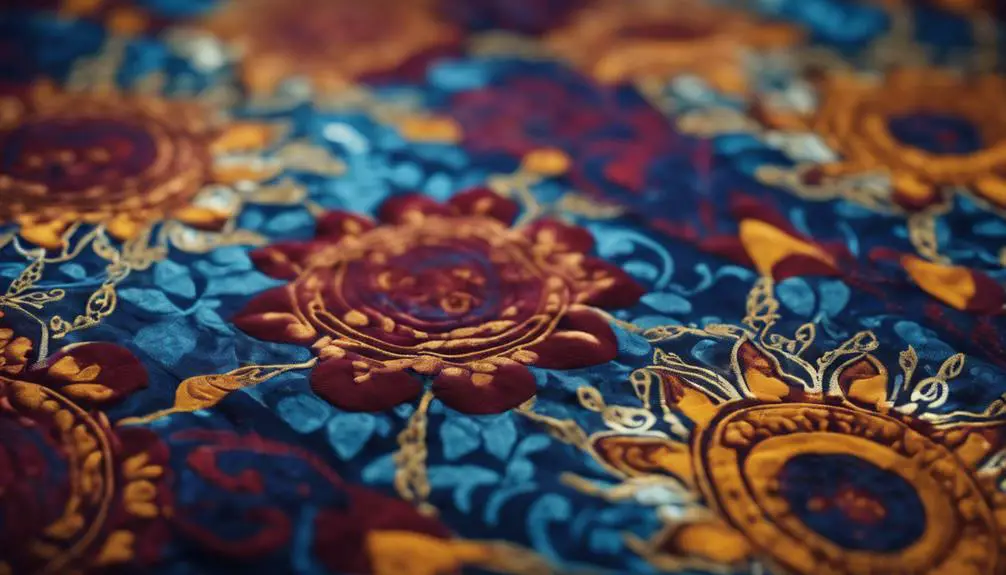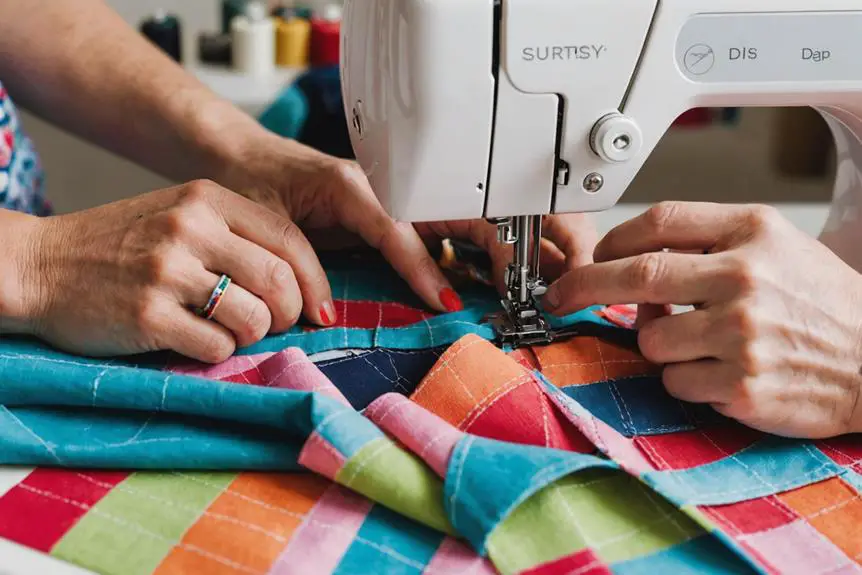To identify authentic batik, start by feeling the fabric—it's soft and supple with a unique texture from the wax-resist dyeing technique. Check the reverse side; it should mirror the front design, showcasing meticulous craftsmanship. Look for handmade imperfections, like variations in line thickness or minor wax cracks, which indicate authenticity. Also, appreciate the cultural significance tied to each piece, as batik tells stories of local traditions. Finally, differentiate between types like Batik Tulis and Batik Cap to gauge value. You'll soon discover there's much more to uncover about this treasured art form.
Feel the Fabric
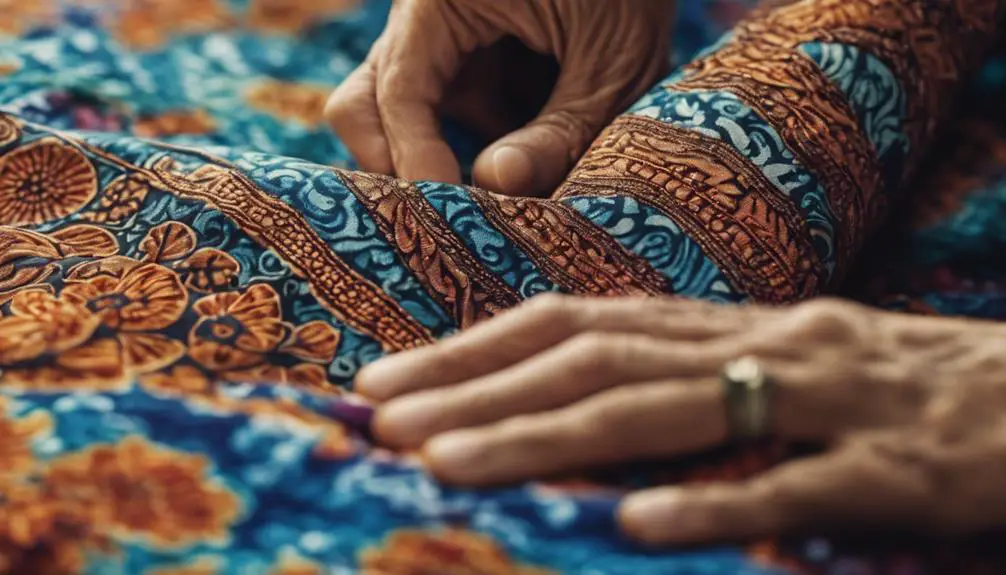
When you touch authentic batik fabric, you'll immediately notice its soft, supple feel against your skin. This comfort is a hallmark of genuine batik, crafted through a meticulous dyeing process that highlights its unique texture. As you run your fingers over the fabric, you'll feel the slightly raised, waxy texture, a result of the traditional wax-resist dyeing technique used by artisans.
Authentic batik is not just about aesthetics; it's a reflection of cultural heritage, showcasing the craftsmanship involved in creating handcrafted batik. Look closely for inherent irregularities, such as slubs or variations in the weave. These minor flaws are indicators of quality, revealing the human touch behind each piece. The textural effects of batik are essential, showcasing the artisan's skill and dedication to their craft.
Moreover, genuine batik often carries a unique, earthy scent from the natural wax used, setting it apart from synthetic or machine-made textiles. So, when you feel the fabric, remember that you're not just touching a textile; you're experiencing a rich tradition and the artistry that goes into every inch of it.
Examine the Reverse Side
After feeling the fabric, the next step in identifying authentic batik is to examine the reverse side. The reverse side of genuine batik showcases a mirrored version of the front design, revealing the wax-resist dyeing technique employed during its creation. As you look closely, you'll notice distinct resist patterns, a result of the hot wax applied before dyeing.
This examination is essential, as it highlights the meticulous craftsmanship involved in batik-making. The marks left by the dyeing process often reflect the labor-intensive nature of creating these intricate designs. Unlike printed batik, which may show faded colors or smudging on the back, authentic batik exhibits consistent patterns on both sides.
Take a moment to appreciate the artistry involved; the intricate details visible on the reverse side not only enhance its beauty but also serve as a hallmark of quality. By carefully examining the reverse side, you can confidently determine if you're looking at genuine batik, ensuring that your collection boasts true artistic value. Recognizing these features will deepen your appreciation for this beautiful textile tradition.
Recognize Handmade Imperfections
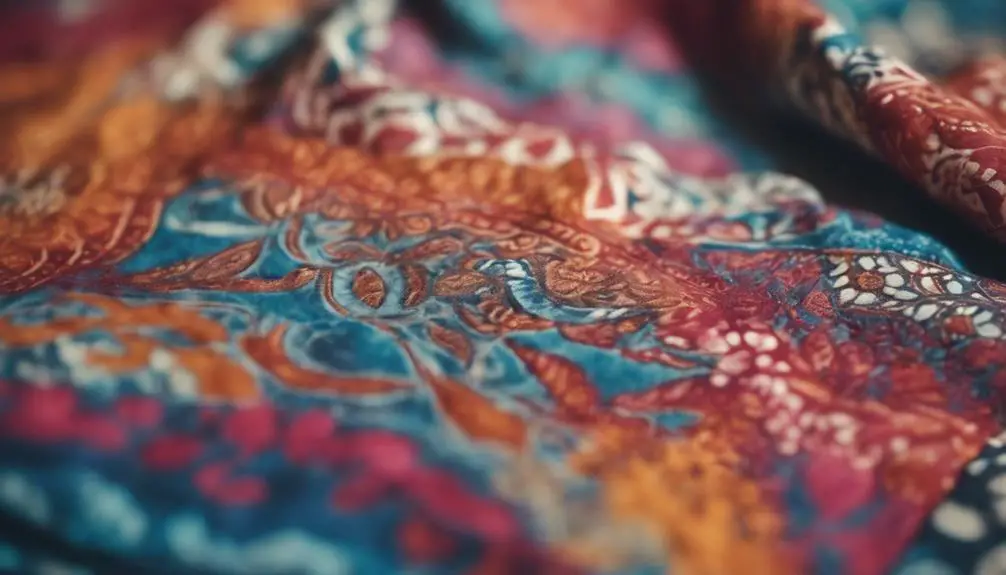
While examining batik, you'll quickly notice that handmade pieces often boast unique imperfections that set them apart from mass-produced textiles. These distinct imperfections not only enhance the aesthetic appeal but also signify the authenticity of the craftsmanship behind each piece.
- Variations in line thickness showcase the artisan's unique touch.
- Minor wax cracks are a natural result of the dyeing process.
- Subtle irregularities in patterns reflect the skill of the artisan.
When you look closely at handmade batik, you'll see that these subtle irregularities are evidence of its handcrafted nature. Unlike uniform mass-produced fabrics, every piece of genuine batik carries the hallmark of traditional batik techniques, celebrating cultural heritage. The presence of minor wax cracks indicates the organic nature of the dyeing process, further proving its authenticity.
These unique characteristics not only contribute to the fabric's charm but also preserve the legacy of the artisan's skill. By understanding and recognizing these handmade imperfections, you can confidently identify and appreciate authentic batik, ensuring that you're supporting true craftsmanship.
Understand Cultural Significance
Batik isn't just a beautiful textile; it's a vibrant reflection of cultural identity and heritage. Recognized by UNESCO as a Masterpiece of Oral and Intangible Heritage, batik showcases the rich cultural significance of Indonesian culture. Each intricate design and pattern in batik tells a story, often carrying specific meanings that embody local traditions and values.
With historical roots dating back to the 6th century, batik serves as a symbol of Indonesian pride and identity. By understanding the art of batik, you appreciate how it connects communities and generations. The variety in techniques, such as batik tulis and batik cap, highlights the diversity of regional influences, making each piece unique.
Moreover, supporting local artisans who produce genuine batik clothing is essential for preserving this traditional craft. The textile production of batik not only sustains artistic expression but also provides livelihoods for many families. When you choose batik, you're not just wearing a piece of cloth; you're embracing a rich cultural narrative that deserves recognition and respect. By valuing this art form, you contribute to the ongoing legacy of batik and the communities that create it.
Explore Types of Batik
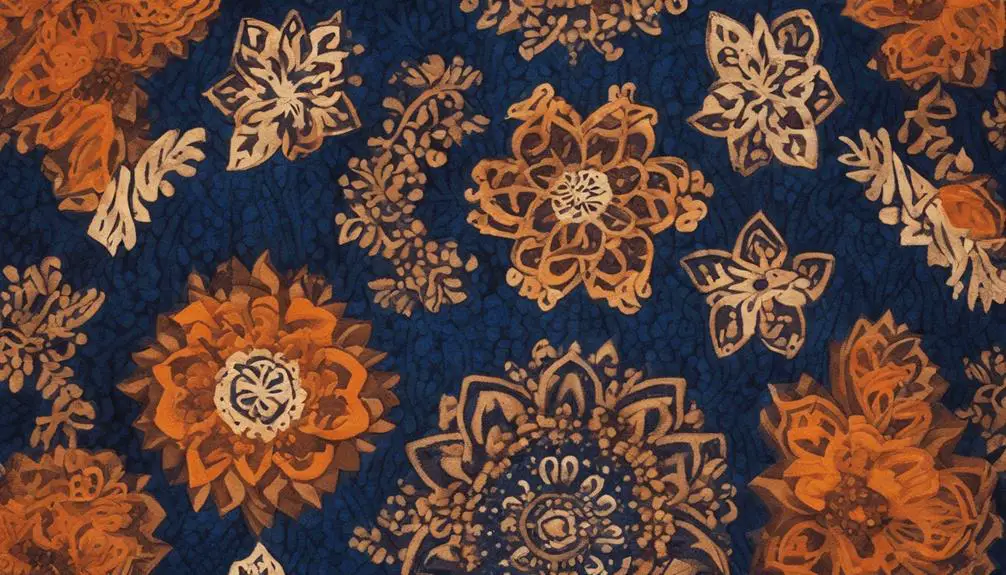
Understanding the cultural significance of batik opens the door to exploring its various types, each showcasing unique techniques and artistry. You'll find that batik can be categorized into three main types, each with distinct production methods and intricacies:
- Batik Tulis: Hand-drawn with a canting tool and hot wax, it's the most labor-intensive and valuable form. You'll appreciate its unique designs and the craftsmanship involved.
- Batik Cap: This type uses a stamp to apply patterns, making it quicker and less costly than batik tulis. However, it still retains traditional qualities.
- Printed Batik: Utilizing chemical dyes and mass production techniques, printed batik offers brighter colors but lacks the authenticity and craftsmanship of the traditional forms.
When you look at batik, the value often hinges on the production method. Batik tulis stands out as the most esteemed due to its intricate artistry and detailed craftsmanship. So, as you explore batik, pay attention to how these types reflect the cultural heritage and artistry behind each piece.
Frequently Asked Questions
How to Differentiate Batik?
To differentiate batik, observe the patterns and colors. Authentic batik has vibrant hues on both sides, unique designs, and a textured feel. Check for natural fibers and handcrafted imperfections; these indicate true craftsmanship.
What Are the Characteristics of Batik?
Batik's characteristics include vibrant, double-sided designs, unique patterns with slight inconsistencies, and natural fibers like cotton or silk. You'll notice a distinct texture from the wax-resist technique, making each piece a true work of art.
What Does a Batik Look Like?
A batik features intricate, colorful patterns that often vary in design. You'll notice a slightly raised, waxy texture on one side, while the reverse displays a mirrored pattern, showcasing the artisan's skill and unique craftsmanship.
What Are the Symbols of Batik?
Batik symbols tell stories and convey meanings. You'll find motifs representing nature, spirituality, and cultural beliefs. Each design, like "Kawung" for purity or "Sido Mukti" for prosperity, reflects unique regional traditions and values.
